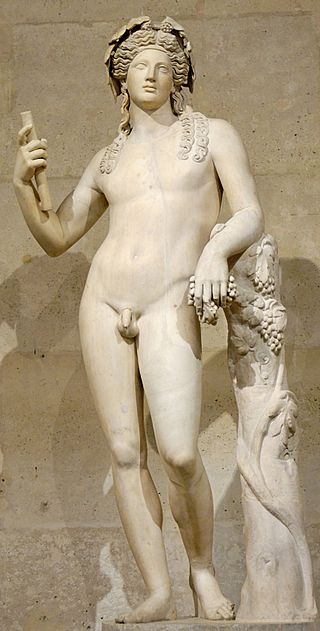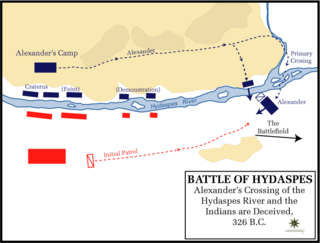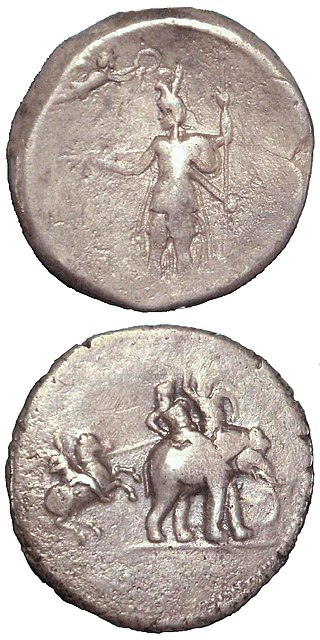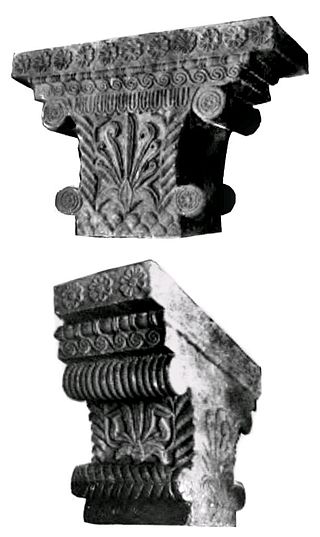
In ancient Greek religion and myth, Dionysus is the god of wine-making, orchards and fruit, vegetation, fertility, festivity, insanity, ritual madness, religious ecstasy, and theatre. He was also known as Bacchus by the Greeks for a frenzy he is said to induce called baccheia. As Dionysus Eleutherius, his wine, music, and ecstatic dance free his followers from self-conscious fear and care, and subvert the oppressive restraints of the powerful. His thyrsus, a fennel-stem sceptre, sometimes wound with ivy and dripping with honey, is both a beneficent wand and a weapon used to destroy those who oppose his cult and the freedoms he represents. Those who partake of his mysteries are believed to become possessed and empowered by the god himself.

Year 326 BC was a year of the pre-Julian Roman calendar. At the time, it was known as the Year of the Consulship of Visolus and Cursor. The denomination 326 BC for this year has been used since the early medieval period, when the Anno Domini calendar era became the prevalent method in Europe for naming years.

Semele, or Thyone in Greek mythology, was the youngest daughter of Cadmus and Harmonia, and the mother of Dionysus by Zeus in one of his many origin myths.

In Greek mythology, maenads were the female followers of Dionysus and the most significant members of his retinue, the thiasus. Their name, which comes from μαίνομαι, literally translates as 'raving ones'. Maenads were known as Bassarids, Bacchae, or Bacchantes in Roman mythology after the penchant of the equivalent Roman god, Bacchus, to wear a bassaris or fox skin.
Aretus was one of several characters in Greek mythology:
Nonnus of Panopolis was the most notable Greek epic poet of the Imperial Roman era. He was a native of Panopolis (Akhmim) in the Egyptian Thebaid and probably lived in the 5th century CE. He is known as the composer of the Dionysiaca, an epic tale of the god Dionysus, and of the Metabole, a paraphrase of the Gospel of John. The epic Dionysiaca describes the life of Dionysus, his expedition to India, and his triumphant return. It was written in Homeric Greek and in dactylic hexameter, and it consists of 48 books at 20,426 lines.

Pactolus, also called Chrysorrhoas (Χρυσορρόας), the modern Sart Çayı'Sardis stream', is a river near the Aegean coast of Turkey. The river rises from Mount Tmolus, flows through the ruins of the ancient city of Sardis, and empties into the Gediz River, the ancient Hermus. The Pactolus once contained electrum that was the basis of the economy of the ancient state of Lydia, which used the naturally occurring alloy of gold and silver to mint the first coins under Alyattes of Lydia.

In ancient times, trade between the Indian subcontinent and Greece flourished with silk, spices and gold being traded. The Greeks invaded South Asia several times, starting with the conquest of Alexander the Great and later with the Indo-Greek Kingdom.

The Jhelum River is a river in the northern Indian subcontinent. It originates at Verinag and flows through the Indian-administered territory of Jammu and Kashmir, into Pakistan-administered Azad Kashmir, then the Pakistani province of Punjab. It is the westernmost of the five rivers of the Punjab region, and flows through the Kashmir Valley. It is a tributary of the Chenab River and has a total length of about 725 kilometres (450 mi).

The Dionysiaca is an ancient Greek epic poem and the principal work of Nonnus. It is an epic in 48 books, the longest surviving poem from Greco-Roman antiquity at 20,426 lines, composed in Homeric dialect and dactylic hexameters, the main subject of which is the life of Dionysus, his expedition to India, and his triumphant return to the west.

In Greek mythology, Pasithea, or Pasithee, was one of the Graces and the wife of Hypnos. In the Dionysiaca, the epic poem of Nonnus, she is one of the three attendant Graces of Aphrodite.
In Greek mythology, Thyamis was a commander, along with his brothers, the Cyraioi, who fought together with Deriades against Dionysus in the Indian War. He was son of Tarbelus and is mentioned in Nonnus Dionysiaka. Another individual named Thyamis was a warrior in the army of Dionysus during the Indian War. He was killed by King Deriades of India.
In Greek mythology, Astris or Asteria was, in Nonnus's Dionysiaca, one of the Heliades, daughters of Helios, either by the Oceanid Clymene or the Oceanid Ceto. She married the river god Hydaspes and became mother of Deriades, king of the Indians.
In Greek mythology, Nicaea or Nikaia is a Naiad nymph of the springs or fountain of the ancient Greek colony of Nicaea in Bithynia or else the goddess of the adjacent lake Ascanius. She is the daughter of the river-god Sangarius and the mother-goddess Cybele. By the god of wine, Dionysus, she mothered Telete (consecration) and Satyrus, as well as other children.
In Greek mythology, Hydaspes, was a river god of Pentapotamia with an extraordinary swift stream that flows into the Saronitic Syrtis. It is the modern day Jhelum River.

For the ancient Greeks, “India" referred to the geographical region situated east of Persia and south of the Himalayas. During various periods of history, the term expanded to refer to the much wider Indian subcontinent or the much less extensive Indus Plain.
In Greek mythology, Opheltes may refer to several figures in Greek mythology, including:
In Greek mythology, Cleochus was the name shared by two individuals:
In Greek mythology, Pherespondus was the satyr herald of Dionysus during the Indian War.
In Greek mythology, Ormenius may refer to various characters:









